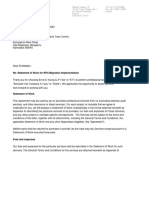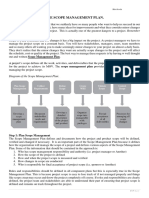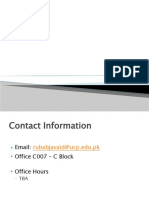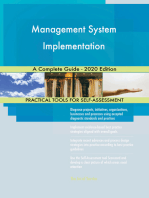Introduction To Project Management: Soumitra Chakraborty
Introduction To Project Management: Soumitra Chakraborty
Uploaded by
Soumitra ChakrabortyCopyright:
Available Formats
Introduction To Project Management: Soumitra Chakraborty
Introduction To Project Management: Soumitra Chakraborty
Uploaded by
Soumitra ChakrabortyOriginal Description:
Original Title
Copyright
Available Formats
Share this document
Did you find this document useful?
Is this content inappropriate?
Copyright:
Available Formats
Introduction To Project Management: Soumitra Chakraborty
Introduction To Project Management: Soumitra Chakraborty
Uploaded by
Soumitra ChakrabortyCopyright:
Available Formats
Introduction to Project Management
Soumitra Chakraborty
2
What exactly is a project?
PM 1 Im in charge of the construction of a retail development in the centre
of a large town. There are 26 retail units and a super market in the complex.
My main responsibilities are to co-ordinate the work of the various contractors
to ensure that the project is completed to specification, within budget and on
time.
PM 2 I am directing a team of research scientists. We are running trials on a
new analgesic drug on behalf of a pharmaceutical company. It is my
responsibility to design the experiments and make sure that proper scientific
and legal procedures are followed, so that our results can be subjected to
independent statistical analysis.
PM 3- The international aid agency which employs me is sending me to New
Delhi to organize the introduction of multimedia resources at a teachers
training college. My role is quite complex. I have to make sure that
appropriate resources are purchased- and in some cases developed within the
college. I also have to encourage the acceptance of these resources by
lecturers and students within the college.
3
PM 2 I am directing a team of research scientists. We are
running trials on a new analgesic drug on behalf of a
pharmaceutical company. It is my responsibility to design the
experiments and make sure that proper scientific and legal
procedures are followed, so that our results can be subjected to
independent statistical analysis.
PM 3- The international aid agency which employs me is sending
me to New Delhi to organize the introduction of multimedia
resources at a teachers training college. My role is quite
complex. I have to make sure that appropriate resources are
purchased- and in some cases developed within the college. I
also have to encourage the acceptance of these resources by
lecturers and students within the college.
PM 1 Im in charge of the construction of a retail development
in the centre of a large town. There are 26 retail units and a
super market in the complex. My main responsibilities are to co-
ordinate the work of the various contractors to ensure that the
project is completed to specification, within budget and on time.
Project is not defined by the type of outcome it is set up to achieve
4
Basic Definition of Project
Have a specific and finite tasks to be
accomplished, whether large or small
scales, long or short run
A Project is a temporary endeavor
undertaken to create a unique
product, service, or result``.
Characteristics of a Project
5
Purpose
Project
usually a one-time activity with a set of desired
end result
can be divided into subtasks, which required
coordination & control
Life Cycle
Project life cycle
slow beginning progress to a buildup of size
peak begin decline finally must terminate
Characteristics of a Project
6
Interdependencies
Projects interact with other project being carried out
simultaneously by parent org., but always interacts with the
parents standard, ongoing operations, etc.
The patterns of interaction between functional dept. may change.
e.g:
Project mgr- keep these interactions clear & maintain
Marketing
Finance
Manufacturing
Finance
Marketing
Beginning
of project
Intermediate of project
End of
project
Definition and Characteristics of a
Project
Uniqueness
Every project are unique no two projects are the same
Some degree of customization is there
Conflict
Project mgr. full of conflict; projects compete with
functional dept. for resources & people
Project members conflicting for projects resources &
leadership roles in solving problems; deal with clients &
org.
Individuals conflict two bosses at the same time;
different objectives & priorities
7
Difference between project management
and production management
Project management
Production
management
Quantity Only one project at a time
Large numbers
(mass production)
Product No two projects are the same
Similar but with variety
(e.g;consumer goods-
cars,household,computers,
etc)
Input to the
process
Brought to the site
(e.g; equipments, man,
material)
Put together in a
facility (factory) but
based on product
No of
process and
activities
Most activities carried out
once
Carried out
repetitively/more
than once
8
Aspect
Mgmt
Four different types
of projects . . .
Shaft sinking at an Australian nickel mine
1 Civil or chemical engineering and
construction projects
- construction
- land reclamation
- tunnels and bridges
- mining and quarrying
- petrochemical plant
- oil and gas
2 Manufacturing projects
(the outcome is a product)
- new product development
- equipment manufacture
- shipbuilding
- heavy engineering
- aircraft construction
- pharmaceuticals
- food processing
Ingersoll milling machine
3 Management projects
(often in-house)
- organize an exhibition or stage
play
- relocate a company
- quality improvement project
- marketing project
- new production or IT facility
- disaster recovery
4 Projects for pure scientific research
- high risk of failure
- also possibility of high rewards
- possible public apprehension
- outcome often unpredictable
Why Project Management?
14
Project manager expected to coordinate & integrate all
activities to reach projects goals
Project allows the mgr to be responsive to the client &
environ, to identify & correct problems, make timely
decisions, ensure mgrs at separate tasks do not sub-
optimize
Advantages of project mgmt;
Better control & better customer relations
Shorter development times, lower costs, higher quality & reliability,
higher profit margins
Sharper orientation towards results, better interdepartmental
coordination & higher worker morale
Some disadvantages of project mgmt
15
Increased organizational complexity
Increase the likelihood that organizational policy being
violated project mgr being autonomous
Higher costs, management difficulties, low personnel
utilization
PM is difficult even when everything goes well - what
more if things go badly
Project organization is the only feasible way to
accomplish certain goals - literally not possible to
design & build a major weapon system in a timely &
economically acceptable manner, except through
project organization i.e. applying PM tools
The Triple Constraint
of Project Management
16
The Quadruple Constrains
of Project Management
1-17
Project Management
Framework
1-18
Project Life Cycle
Phases of the Project Life Cycle 1
The first phase involves the identification of a
need, problem, or opportunity.
The need and requirements are usually written by the
customer into a document called a request for proposal
(RFP).
Phases of the Project Life Cycle 2
The second phase is the development of a
proposed solution to the need or problem.
This phase results in the submission of a proposal.
The customer and the winning contractor negotiate
and sign a contract (agreement).
Phases of the Project Life Cycle 3
The third phase is performing the project.
Different types of resources are utilized
Results in the accomplishment of the project
objective
Phases of the Project Life Cycle 4
The final phase is terminating the project.
Perform close-out activities
Evaluate performance
Invite customer feedback
Project Life Cycle
5. Requirements
Project Management Maturity
Organizational Project
Management Performance
Project management maturity is a
widely accepted term when
discussing the extent that an
organization has adopted project
management processes.
PM Maturity can be identified
through key project related areas
(i.e organizational structure,
processes, etc).
The Benefits Of Being Mature!
Manage all projects undertaken
effectively.
Continually improve the
performance of all projects
undertaken.
Create an organization-wide ability
for managing projects.
Define roles and responsibilities for
carrying out all project-related
activities.
Achieve strategic goals.
Project Management Maturity Model(PMMM)
PM Maturity is ranked
into 1 of 5 maturity
levels.
Integrated multi-project
Planning and Control
Ad-hoc
Level1
Planned
Level 2
Managed
Level 3
Integrated
Level 4
Sustained
Level 5
Basic PM Processes
Individual Project
Planning
Systematic Project
Planning and Control
Continuous PM
Process Improvement
Level 1
Level 1 :Common
Language
Recognize the need
Acquire knowledge
Ad-hoc
Level1
Common Language
Level 2
Level 2: Common
processes: Common
processes defined
Success can be
repeated
Ad-hoc
Level1
Planned
Level 2
Common Language
Common Processes
Level 3
Singular Methodology
:combining all corporate
methodology into
singular methodology
Ad-hoc
Level1
Planned
Level 2
Managed
Level 3
Common Language
Common Process
Singular Methodology
Level 4
Process Improvement
Best Practices
Benchmarking
Ad-hoc
Level1
Planned
Level 2
Managed
Level 3
Integrated
Level 4
Common Language
Common Processes
Singular Methodology
Level 5
Concept of quality
Decision of
benchmarking
Benchmarking
Ad-hoc
Level1
Planned
Level 2
Managed
Level 3
Integrated
Level 4
Sustained
Level 5
Common Language
Common Processes
Singular Methodology
Continuous Process
Improvement
PM Maturity Model in Practice
Overlap of processes.
Overlap level 1 & 2
Overlap level 3 & 4
Overlap level 4 & 5
Project Selection
Project Selection
Project selection is the process of evaluating
individual projects or groups of projects, and
then choosing to implement some set of them so
that the objectives of the parent organization will
be achieved
Managers often use decision-aiding models to
extract the relevant issues of a problem from the
details in which the problem is embedded
Models represent the problems structure and
can be useful in selecting and evaluating
projects
Criteria for Project Selection Models
Realism - reality of managers decision
Capability- able to simulate different scenarios and
optimize the decision
Flexibility - provide valid results within the range of
conditions
Ease of Use - reasonably convenient, easy execution,
and easily understood
Cost - Data gathering and modeling costs should be low
relative to the cost of the project
1Easy Computerization - must be easy and convenient
to gather, store and manipulate data in the model
Nature of Project Selection
Models
2 Basic Types of Models
Numeric
Nonnumeric
Two Critical Facts:
Models do not make decisions - People do!
All models, however sophisticated, are only
partial representations of the reality the are
meant to reflect
Nonnumeric Models
Sacred Cow - project is suggested by a senior and powerful
official in the organization
Operating Necessity - the project is required to keep the
system running
Competitive Necessity - project is necessary to sustain a
competitive position
Product Line Extension - projects are judged on how they fit
with current product line, fill a gap, strengthen a weak link, or extend
the line in a new desirable way.
Comparative Benefit Model - several projects are
considered and the one with the most benefit to the firm is selected
Numeric Models:
Profit/Profitability
Payback period - initial fixed investment/estimated annual
cash inflows from the project
Average Rate of Return - average annual profit/average
investment
Discounted Cash Flow - Present Value Method
Internal Rate of Return - Finds rate of return that equates
present value of inflows and outflows
Profitability Index - NPV of all future expected cash
flows/initial cash investment
You might also like
- Early Life Support Plan Template v1.0Document12 pagesEarly Life Support Plan Template v1.0Mário Pintaudi100% (1)
- Vision - Scope. Time-Tracker 2.0Document7 pagesVision - Scope. Time-Tracker 2.0ВиталийВладимирович100% (1)
- SPM Solution 2073 DK - ManDocument18 pagesSPM Solution 2073 DK - Mansaurav updNo ratings yet
- A Software Design Specification TemplateDocument12 pagesA Software Design Specification TemplateKarthic KeyanNo ratings yet
- Assignment No 4Document4 pagesAssignment No 4heemishaNo ratings yet
- T BCG Scrum ProcessDocument2 pagesT BCG Scrum ProcessinterpabloNo ratings yet
- Certification Course Brochure - CMDocument2 pagesCertification Course Brochure - CMnirpexpatelNo ratings yet
- Ambulance SOFTWARE - Project PlanDocument11 pagesAmbulance SOFTWARE - Project Planovina peirisNo ratings yet
- BS - P2M - 002 - Equipment Maintenance - ExternalDocument3 pagesBS - P2M - 002 - Equipment Maintenance - ExternalMohammed alsalahiNo ratings yet
- Azure VMware SolutionDocument4 pagesAzure VMware SolutionsivakumarNo ratings yet
- Microsoft Azure VMware Solution Advanced SpecializationDocument4 pagesMicrosoft Azure VMware Solution Advanced Specializationlfi91509 zslszNo ratings yet
- User Acceptance TestDocument10 pagesUser Acceptance TestrejinvijayNo ratings yet
- EY Company A SoW Nov 4th 2020 Delhi OfficeDocument23 pagesEY Company A SoW Nov 4th 2020 Delhi OfficeJinkal patwariNo ratings yet
- Wissen Automation Company ProfileDocument19 pagesWissen Automation Company ProfileBawa KambojNo ratings yet
- Documentation PCT.005 Workflow Purchase Order ApprovalDocument17 pagesDocumentation PCT.005 Workflow Purchase Order ApprovalrajasekeranmadNo ratings yet
- 7 - Documenting Use CaseDocument11 pages7 - Documenting Use CaseSulimanNo ratings yet
- 3.1.1 The Scope MGT Plan - HODocument5 pages3.1.1 The Scope MGT Plan - HO20105167No ratings yet
- Managing Successful Computing ProjectDocument56 pagesManaging Successful Computing ProjectJunaid Farooq100% (1)
- IT Project Documentation TemplateDocument8 pagesIT Project Documentation Templateshahrukh62No ratings yet
- 20200727005509D5181 - ISYS6535 - Session 15-16 - Use Case Modeling Part 1 (Overview, Use Case Descriptions, Activity Diagram For Use Cases)Document20 pages20200727005509D5181 - ISYS6535 - Session 15-16 - Use Case Modeling Part 1 (Overview, Use Case Descriptions, Activity Diagram For Use Cases)Tissyu BasahNo ratings yet
- Statement of Work (SOW)Document3 pagesStatement of Work (SOW)Ali Ghalehban - علی قلعه بانNo ratings yet
- Hardware - Migration - Replication+Method+Downtime+ActivitiesDocument7 pagesHardware - Migration - Replication+Method+Downtime+ActivitiesRakesh Rao SalgarNo ratings yet
- Project RoadmapDocument2 pagesProject RoadmapDamilola OyedepoNo ratings yet
- Project Status Report: A. General InformationDocument4 pagesProject Status Report: A. General InformationBhupinder SinghNo ratings yet
- SQE Week 1 LectureDocument52 pagesSQE Week 1 LectureJavaria tanveer100% (1)
- Pre Project AnalysisDocument7 pagesPre Project AnalysisSanket BhagwateNo ratings yet
- Project Scope StatementDocument7 pagesProject Scope StatementFridaNo ratings yet
- CDC UP Change Management Plan TemplateDocument12 pagesCDC UP Change Management Plan TemplateChloe J StewartNo ratings yet
- Sfsu Business Requirements Template v1.6Document3 pagesSfsu Business Requirements Template v1.6yashankNo ratings yet
- Ziitrics Solutions Microsoft Dynamics AX ProposalDocument13 pagesZiitrics Solutions Microsoft Dynamics AX ProposalMezie Emelonye0% (1)
- Unit 9 Assignment 2 BriefDocument3 pagesUnit 9 Assignment 2 BriefHannahNo ratings yet
- Visio-Emergency Change Approval ProcessDocument1 pageVisio-Emergency Change Approval ProcessShekhar GuptaNo ratings yet
- User Acceptance Template PDFDocument2 pagesUser Acceptance Template PDFNiteen JadhavNo ratings yet
- AD 03. Requirements DeterminationDocument41 pagesAD 03. Requirements DeterminationAhmad SentanuNo ratings yet
- Assignment On Requirement CollectionDocument10 pagesAssignment On Requirement CollectionRash StylesNo ratings yet
- Maintenance Plan ForDocument7 pagesMaintenance Plan ForAdoree RamosNo ratings yet
- Oracle Project Management CollaborationDocument21 pagesOracle Project Management CollaborationBalaji NagarajanNo ratings yet
- Unit 9 Project Stakeholder ManagementDocument14 pagesUnit 9 Project Stakeholder ManagementTemesgen ZereabrukNo ratings yet
- Lecture 1Document25 pagesLecture 1Shashi Raj SaiNo ratings yet
- 10ka and IttoDocument25 pages10ka and IttoupendrasNo ratings yet
- Software Testing Estimation TechniquesDocument6 pagesSoftware Testing Estimation TechniquesqabalamuraliNo ratings yet
- The Log - What Every Software Engineer Should Know About Real-Time Data's Unifying Abstraction - LinkedIn EngineeringDocument38 pagesThe Log - What Every Software Engineer Should Know About Real-Time Data's Unifying Abstraction - LinkedIn EngineeringcunchinkoNo ratings yet
- Mboo33 - Project Management Set - 1 Solved AssignmentDocument16 pagesMboo33 - Project Management Set - 1 Solved Assignmentved_laljiNo ratings yet
- Scope Management: The Project Perfect White Paper CollectionDocument4 pagesScope Management: The Project Perfect White Paper CollectionAshok KushwahaNo ratings yet
- 3.3.3 Example - Issue Management Plan, V2.2Document7 pages3.3.3 Example - Issue Management Plan, V2.2Juan VeronNo ratings yet
- The Project Scope Management Plan MSPM1-GC4000 TEMPLATEDocument5 pagesThe Project Scope Management Plan MSPM1-GC4000 TEMPLATEDanNo ratings yet
- Functional SpecificationsDocument6 pagesFunctional Specificationsaugur8866124No ratings yet
- E Commerce Project Feasibility Report by Afsheen JafryDocument21 pagesE Commerce Project Feasibility Report by Afsheen JafryTasfiaNo ratings yet
- Upgrade Oracle Ebs 12-1-3 To 12 22Document47 pagesUpgrade Oracle Ebs 12-1-3 To 12 22sanjayid1980No ratings yet
- Software Requirement Specification 1Document16 pagesSoftware Requirement Specification 1ABbmcNo ratings yet
- BRD Template - Invoice WEBADIDocument5 pagesBRD Template - Invoice WEBADIsatish1981No ratings yet
- Scope Management Plan: Project Management, Project Planning, Templates and AdviceDocument7 pagesScope Management Plan: Project Management, Project Planning, Templates and AdvicecapitanigloNo ratings yet
- I Make Erp Documentation VERSION B1.05.1231Document12 pagesI Make Erp Documentation VERSION B1.05.1231Ahmad Takiyuddin Bin SaadNo ratings yet
- CIS6006-Cyber Security WRIT1Document13 pagesCIS6006-Cyber Security WRIT1akila rajapakshaNo ratings yet
- Software ProcessDocument48 pagesSoftware ProcessJekaa KekaNo ratings yet
- Project 2 - Software Service IndustryDocument13 pagesProject 2 - Software Service IndustryRakhi100% (3)
- Sample Test Plan TemplateDocument15 pagesSample Test Plan TemplateIrina INo ratings yet
- Enterprise School Management: Under The Guidence ofDocument47 pagesEnterprise School Management: Under The Guidence ofHimanshi DhyaniNo ratings yet
- Migration From MSSQL To MySQLDocument10 pagesMigration From MSSQL To MySQLMercedez BenzNo ratings yet
- Management System Implementation A Complete Guide - 2020 EditionFrom EverandManagement System Implementation A Complete Guide - 2020 EditionNo ratings yet
- Public Cloud ERP for Small or Midsize Businesses A Complete Guide - 2019 EditionFrom EverandPublic Cloud ERP for Small or Midsize Businesses A Complete Guide - 2019 EditionNo ratings yet
- Physical Layer of NetworkDocument27 pagesPhysical Layer of NetworkSoumitra ChakrabortyNo ratings yet
- Workbook and Worksheet ObjectDocument24 pagesWorkbook and Worksheet ObjectSoumitra ChakrabortyNo ratings yet
- Electronic Commerce SystemsDocument22 pagesElectronic Commerce SystemsSoumitra ChakrabortyNo ratings yet
- Computer Lab Policy: No Food BeveragesDocument1 pageComputer Lab Policy: No Food BeveragesSoumitra ChakrabortyNo ratings yet
- Lect 1 Advanced Date FunctionsDocument38 pagesLect 1 Advanced Date FunctionsSoumitra ChakrabortyNo ratings yet
- Warehouse Management SystemDocument3 pagesWarehouse Management SystemSoumitra Chakraborty100% (1)
- Excel QuizDocument24 pagesExcel QuizSoumitra ChakrabortyNo ratings yet
- AIMA Women Entrepreneurship Program2.0Document3 pagesAIMA Women Entrepreneurship Program2.0Soumitra ChakrabortyNo ratings yet
- Making A Difference: Admission Open For Mba 2014-16Document1 pageMaking A Difference: Admission Open For Mba 2014-16Soumitra ChakrabortyNo ratings yet
- Technology in Banking Services: Soumitra ChakrabortyDocument84 pagesTechnology in Banking Services: Soumitra ChakrabortySoumitra ChakrabortyNo ratings yet
- From E-Commerce To E-Business: The Convergence of Business and TechnologyDocument25 pagesFrom E-Commerce To E-Business: The Convergence of Business and TechnologySoumitra ChakrabortyNo ratings yet
- 11 ICT For Development Lecture MyanmarDocument99 pages11 ICT For Development Lecture MyanmarHtet Mrak AungNo ratings yet
- Primavera Documentation CenterDocument14 pagesPrimavera Documentation CenterCad NoviceNo ratings yet
- Project Management - MCQsDocument60 pagesProject Management - MCQsramNo ratings yet
- Outline Project Quality Plan (Outline PQP) : 其士建築 (香港) 有限公司 Chevalier Construction (Hong Kong) LimitedDocument28 pagesOutline Project Quality Plan (Outline PQP) : 其士建築 (香港) 有限公司 Chevalier Construction (Hong Kong) LimitedWong ChanNo ratings yet
- Mcq-Project Management UNIT-1Document11 pagesMcq-Project Management UNIT-1Jackson PhinniNo ratings yet
- CS605 Grand Quiz by JunaidDocument16 pagesCS605 Grand Quiz by JunaidtarhumNo ratings yet
- Guide For Effective Benefits Management in Major ProjectsDocument62 pagesGuide For Effective Benefits Management in Major ProjectsranvijayNo ratings yet
- Course Description Course Outcome Course Objectives Introduction CE 413Document40 pagesCourse Description Course Outcome Course Objectives Introduction CE 413Melanie Love Pjr AlcantaraNo ratings yet
- Ostrich FarmingDocument28 pagesOstrich FarmingSnqureshi1167% (3)
- Construction Planning Monitoring Controlling PDFDocument3 pagesConstruction Planning Monitoring Controlling PDFHendra BudimanNo ratings yet
- EAWI023RCDocument75 pagesEAWI023RCconstp2100% (1)
- 2015 Organizational Structure in IT Governance - A Case Study of An ITDocument11 pages2015 Organizational Structure in IT Governance - A Case Study of An IThoukoumatNo ratings yet
- Chương 1Document67 pagesChương 1Hằng Lê Thị CẩmNo ratings yet
- AE4-Course OutlineDocument8 pagesAE4-Course OutlineNeil JohnNo ratings yet
- SPP DocumentsDocument11 pagesSPP Documentsnica100% (1)
- CSQA Questions With Answers BelowDocument20 pagesCSQA Questions With Answers BelowMahesh_M79No ratings yet
- Risk Management in Software Engineering: Prepared by Sneha MudumbaDocument14 pagesRisk Management in Software Engineering: Prepared by Sneha MudumbameenahilNo ratings yet
- Interview Questions & Answers For Planning Engineers: AcknowledgmentDocument27 pagesInterview Questions & Answers For Planning Engineers: AcknowledgmentBoinboin HadratNo ratings yet
- NASA WBS Reference GuideDocument60 pagesNASA WBS Reference GuidePhani_Matt_2334No ratings yet
- Projects OverviewDocument40 pagesProjects OverviewSreeharsha SNo ratings yet
- Project Cost & Time Management: CASE STUDY: Franklin ElectronicsDocument2 pagesProject Cost & Time Management: CASE STUDY: Franklin ElectronicsAbanoub SargiousNo ratings yet
- 5.2 Risk Management: Figure 1: Risk Breakdown Structure (RBS) For House Construction ProjectDocument5 pages5.2 Risk Management: Figure 1: Risk Breakdown Structure (RBS) For House Construction ProjectMuhammad Fauzan Ansari Bin AzizNo ratings yet
- Hossein Ghafarian CV 2023-04-25Document3 pagesHossein Ghafarian CV 2023-04-25HosseinNo ratings yet
- MSP NotesDocument19 pagesMSP NotesAnup DeshmukhNo ratings yet
- What Is A Logframe?: Logical Framework StructureDocument9 pagesWhat Is A Logframe?: Logical Framework StructureEzedin KedirNo ratings yet
- Opm 3 Exec GuideDocument5 pagesOpm 3 Exec GuidePablo Alfredo Perez AlcatruzNo ratings yet
- Chapter1-Chapter6 Isp640Document174 pagesChapter1-Chapter6 Isp640Nina HasyaNo ratings yet




































































































